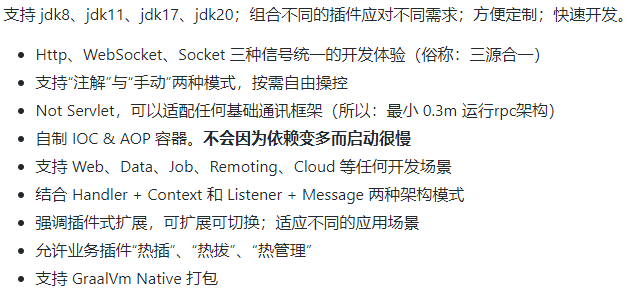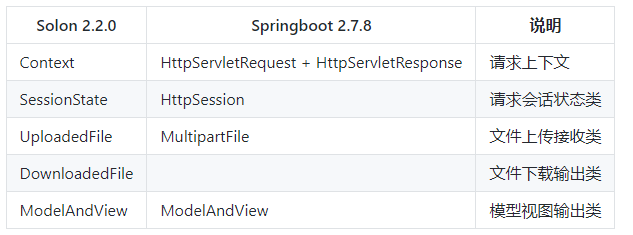solon架构(spring-boot未来最有效的竞争力)
一、现在基本WEB的开发都是用spring-boot来做开发了,但是springboot存在很多弊端。体量大,启动慢等。优点就是生态比较完整,文档说明也比较多。
二、solon架构,是我学习其他框架兼容时了解的,说说其区别之处。
1)solon目前已经有一定规模了,有自己的生态圈了吧

2)solon算的上新生态的开发框架了。
优点:更快、更小、更简单。(主要体现在启动很快,目前基本在5S(不绝对,官网说5~10倍)以内,Qps10万+。打包更小,官方说小1/2~1/10。内存更小。简单主要是在开发上面)


缺点:文档相对较少,虽然后官方实例,但是要完整的用起来还是得自己研究。且存在BUG。
3)与springboot的区别
a、与 Springboot 的常用注解比较
| Solon 2.2.0 | Springboot 2.7.8 | 说明 |
|---|---|---|
| @Inject * | @Autowired | 注入Bean(by type) |
| @Inject("name") | @Qualifier+@Autowired | 注入Bean(by name) |
| @Inject("${name}") | @Value("${name}") + @ConfigurationProperties(prefix="name") | 注入配置 |
| @Singleton | @Scope(“singleton”) | 单例(Solon 默认是单例) |
| @Singleton(false) | @Scope(“prototype”) | 非单例 |
| @Import | @Import + @ComponentScan | 配置组件导入或扫描(一般加在启动类上) |
| @PropertySource | @PropertySource | 配置属性源(一般加在启动类上) |
| @Configuration | @Configuration | 配置类 |
| @Bean | @Bean | 配置Bean |
| @Condition | @ConditionalOnClass + @ConditionalOnProperty | 配置条件 |
| @Controller | @Controller,@RestController | 控制器类 |
| @Remoting | 远程控制器类(即 Rpc 服务端) | |
| @Mapping ... | @RequestMapping,@GetMapping... | 映射 |
| @Param | @RequestParam | 请求参数 |
| @Header | @RequestHeader | 请求头 |
| @Body | @RequestBody | 请求体 |
| @Cookie | @CookieValue | 请求Cookie |
| @Component | @Component | 普通托管组件 |
| @ProxyComponent | @Service,@Dao,@Repository | 代理托管组件 |
| @TestPropertySource | @TestPropertySource | 配置测试属性源 |
| @TestRollback | @TestRollback | 执行测试回滚 |
| LifecycleBean | InitializingBean + DisposableBean | 组件初始化和销毁 |
| Solon 2.2.0 | Java EE(Java 11 后更名为 Jakarta) | |
| LifecycleBean::start | @PostConstruct | 组件构造完成并注入后的初始化 |
| LifecycleBean::stop | @PreDestroy | 组件销毁 |

b、重要的区别,Solon 不是基于 Servlet 的开发框架

c、其他区别也比较多。这里不一一说明。参考地址:https://solon.noear.org/article/compare-springboot
三、开发部分说明:(这里只有cloud相关的,单体的相对简单)
1)集群注册与发现,以nacos为例。
<dependency> <groupId>org.noear</groupId> <artifactId>nacos-solon-cloud-plugin</artifactId> </dependency>
2)配置app.yml(测试只能在resources下),具体配置:https://solon.noear.org/article/148
solon: app: name: demo group: xbd namespace: public cloud: nacos: server: 127.0.0.1:8848
3)rpc适用简单,优点类似dubbo的调用方式,抽公共的接口就行。
<dependency> <groupId>org.noear</groupId> <artifactId>solon-rpc</artifactId> </dependency>
server
@Service @Mapping("/user") @Remoting public class UserServiceImpl implements IUserService { @Tran public List<String> listUser() { List<String> users = new ArrayList<String>(); for (int i = 0; i < 5; i++) { users.add("user" + i); } return users; } }
client
@NamiClient(name = "demo", path = "/user", headers = ContentTypes.PROTOBUF) private IUserService userService;

4)认证(jwt)
<dependency> <groupId>org.noear</groupId> <artifactId>solon.auth</artifactId> </dependency> <dependency> <groupId>org.noear</groupId> <artifactId>solon.sessionstate.jwt</artifactId> </dependency>
配置
server: port: 8673 session: #超时配置。单位秒(可不配,默认:7200) timeout: 86400 state: #可共享域配置(可不配,默认当前服务域名;多系统共享时要配置) domain: "xbd.auth.com" jwt: #Jwt 令牌变量名;(可不配,默认:TOKEN) name: "Authorization" #Jwt 密钥(使用 JwtUtils.createKey() 生成);(可不配,默认:xxx) secret: "QQRsCNRmPqZQtAo5ANqZ9OgG5N2mOqZl5D3i1VSDvJs=" #Jwt 令牌前缀(可不配,默认:空) prefix: "Bearer" #Jwt 允许超时;(可不配,默认:true);false,则token一直有效 allowExpire: true #Jwt 允许自动输出;(可不配,默认:true);flase,则不向header 或 cookie 设置值(由用户手动控制) allowAutoIssue: false #Jwt 允许使用Header传递;(可不配,默认:使用 Cookie 传递);true,则使用 header 传递 allowUseHeader: true
@Controller @Mapping("/auth") public class AuthController { @Inject private IUserService userService; @Get @Mapping("/test") public Result test(Context context) { return Result.succeed(context.session("userId")); } @Post @Mapping("/login") public Result login(Context context, @Body JSONObject jsonObject) { String username = jsonObject.getString("username"); String password = jsonObject.getString("password"); boolean result = userService.checkUser(context, username, password); return result ? Result.succeed() : Result.failure("密码错误!"); } }
@Service public class UserServiceImpl extends ServiceImpl<UserMapper, User> implements IUserService { @Override public boolean checkUser(Context context, String username, String password) { QueryWrapper<User> wrapper = new QueryWrapper<>(); wrapper.eq("username", username); User user = baseMapper.selectOne(wrapper); if (user == null) { throw new ApiException("用户不存在"); } boolean check = DigestUtil.bcryptCheck(password, user.getPassword()); if (check) { context.sessionSet("userId", user.getId()); context.sessionSet("username", user.getUsername()); context.cookieSet("TOKEN", context.sessionState().sessionToken()); } return check; } }
@Configuration public class AuthConfiguration { @Bean public AuthAdapter authAdapter() { return new AuthAdapter() // .loginUrl("/login") //设定登录地址,未登录时自动跳转(如果不设定,则输出401错误) .addRule(r -> r.include("/**").exclude("/auth/login").verifyLogined()) //添加规则 .processor(new AuthProcessor() { @Override public boolean verifyIp(String ip) { return false; } @Override public boolean verifyLogined() { Context context = ContextUtil.current(); if (context.session("userId") != null) { return true; } return false; } @Override public boolean verifyPath(String path, String method) { return false; } @Override public boolean verifyPermissions(String[] permissions, Logical logical) { return false; } @Override public boolean verifyRoles(String[] roles, Logical logical) { return false; } }).failure((ctx, rst) -> { System.out.println(rst); ctx.output(JSONObject.toJSONString(rst)); }); } }
参考地址:https://solon.noear.org/article/59 https://solon.noear.org/article/132
说实话这个认证太简单了,二次校验等等问题,相对于security真的太轻量级了。在结合redis缓存,基本可以最到登陆和登出的一些判定了。
5)多数据源:地址:https://solon.noear.org/article/231
<dependency> <groupId>org.noear</groupId> <artifactId>mybatis-plus-extension-solon-plugin</artifactId> </dependency>
@Configuration public class DataSourceConfiguration { @Bean(name = "default", typed = true) public DataSource dataSource(@Inject("${datasource.default}") HikariDataSource dataSource){ return dataSource; } }
不多说,应用就会了。
6)网关(官网推荐nginx等三方产品):说实话这个就真的比较一般了。数据转发出现乱码的情况,改用其他的就正常。
<dependency> <groupId>org.noear</groupId> <artifactId>solon-api</artifactId> </dependency> <!-- 适用httputils乱码 --> <dependency> <groupId>org.noear</groupId> <artifactId>solon.cloud.httputils</artifactId> </dependency>
@Slf4j @Component @Mapping("/**") public class RouterConfiguration extends Gateway { @Override protected void register() { //添加个前置处理 before(ctx -> { String token = ctx.sessionState().sessionToken(); System.out.println(token); }); //添加缺省处理 add(Any.class); } public static class Any { @Mapping public String any(Context ctx) throws Throwable { //检测请求,并尝试获取二级接口服务名 String serviceName = ctx.pathMap("/{serviceName}/**").get("serviceName"); if (serviceName == null) { log.error(MessageFormat.format("{0} service not found", serviceName)); throw new ApiException(500, "服务异常!"); } //转发请求 String method = ctx.method(); String server = LoadBalance.get(serviceName).getServer(); if (server == null) { log.error(MessageFormat.format("{0} service not exception", serviceName)); throw new ApiException(500, "服务异常!"); } HttpRequest request = HttpUtil.createRequest(Method.valueOf(method), server + ctx.path().substring(StrUtil.indexOf(ctx.path(), '/', 2))); request.addHeaders(ctx.headerMap()); request.header(CloudClient.trace().HEADER_TRACE_ID_NAME(), CloudClient.trace().getTraceId()); request.body(ctx.body()); HttpResponse response = request.execute(); if (200 == response.getStatus()) { return response.body(); } else { throw new ApiException(response.getStatus(), response.body()); } } } @Override public void render(Object obj, Context context) throws Throwable { if (context.getRendered()) { return; } context.setRendered(true); Object result; if (obj instanceof ApiException) { ApiException exception = (ApiException) obj; result = exception.data(); } else { //处理java bean数据(为扩展新的) result = obj; } context.result = result; //如果想对输出时间点做控制,可以不在这里渲染(由后置处理进行渲染) context.render(context.result); } }
public class ApiException extends DataThrowable { public ApiException() { super.data(Result.failure()); } public ApiException(int code, String message) { super.data(Result.failure(code, message)); } public ApiException(Throwable cause) { super(cause); super.data(Result.failure(cause.getMessage())); } public ApiException(String message) { super(message); super.data(Result.failure(message)); } public ApiException(String message, Throwable cause) { super(message, cause); super.data(Result.failure(message)); } }
四、开发的几个重要部分,简单搞了一下,其他的都有对应策略,这里不细讲了。
五、总体来说这套框架还是非常优秀的。但是还是存在很多bug吧,个人准备弄着玩。
demo地址:https://gitee.com/lilin409546297/solon-demo





 浙公网安备 33010602011771号
浙公网安备 33010602011771号